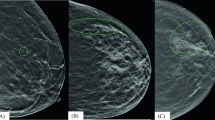Abstract
Background
This study aimed to evaluate the risk of breast cancer development for women under surveillance after surgery for atypical ductal hyperplasia (ADH), as well as the clinical and pathologic factors associated with breast cancer development.
Methods
From November 2003 to December 2014, the study included 205 women (mean age, 47.1 ± 11.2 years; range 18–73 years) with a pathologic diagnosis of ADH at surgical excision who had preoperative mammography and ultrasonography (US) images and pathology slides available for review. The patients were classified into three groups according to the detection method as follows: negative group (with ADH occult on imaging), mammography group (with ADH detected on mammography), and US group (with ADH detected on US only). Clinical, radiologic, and histopathologic factors associated with breast cancer development after ADH surgery were evaluated.
Results
Breast cancer developed in 15 patients (7.3%) during surveillance after ADH surgery (follow-up period, 63.9 ± 40.8 months). Palpable lesions had significantly higher rates of breast cancer development after ADH surgery (26.7% vs 6.8%; P = 0.045). Breast cancer development after ADH surgery did not differ according to the detection method (P = 0.654). Palpability was significantly associated with breast cancer development during surveillance after ADH surgery (hazard ratio, 3.579; 95% confidence interval 1.048–12.220; P = 0.042).
Conclusion
The breast cancer development rate for women under surveillance after ADH surgery was 7.3%. Palpability at the time of ADH diagnosis was significantly associated with breast cancer development.


Similar content being viewed by others
References
Hartmann LC, Radisky DC, Frost MH, et al. Understanding the premalignant potential of atypical hyperplasia through its natural history: a longitudinal cohort study. Cancer Prev Res Philadelphia. 2014;7:211–7.
Donaldson AR, McCarthy C, Goraya S, et al. Breast cancer risk associated with atypical hyperplasia and lobular carcinoma in situ initially diagnosed on core-needle biopsy. Cancer. 2018;124:459–65.
Co M, Kwong A, Shek T. Factors affecting the under-diagnosis of atypical ductal hyperplasia diagnosed by core needle biopsies: a 10-year retrospective study and review of the literature. Int J Surg. 2018;49:27–31.
Racz JM, Degnim AC. When does atypical ductal hyperplasia require surgical excision? Surg Oncol Clin N Am. 2018;27:23–32.
Menen RS, Ganesan N, Bevers T, et al. Long-term safety of observation in selected women following core biopsy diagnosis of atypical ductal hyperplasia. Ann Surg Oncol. 2017;24:70–6.
Degnim AC, Visscher DW, Berman HK, et al. Stratification of breast cancer risk in women with atypia: a Mayo cohort study. J Clin Oncol. 2007;25:2671–7.
Visscher DW, Frost MH, Hartmann LC, et al. Clinicopathologic features of breast cancers that develop in women with previous benign breast disease. Cancer. 2016;122:378–85.
Menes TS, Kerlikowske K, Lange J, Jaffer S, Rosenberg R, Miglioretti DL. Subsequent breast cancer risk following diagnosis of atypical ductal hyperplasia on needle biopsy. JAMA Oncol. 2017;3:36–41.
Howard-McNatt M. Atypical ductal hyperplasia: what is the current risk for developing breast cancer? JAMA Oncol. 2017;3:20–1.
Hartmann LC, Degnim AC, Dupont WD. Atypical hyperplasia of the breast. N Engl J Med. 2015;372:1271–2.
American College of Radiology. Breast imaging reporting and data system, 5th ed. American College of Radiology, Reston, VA, 2013.
Park JW, Ko KH, Kim EK, Kuzmiak CM, Jung HK. Non-mass breast lesions on ultrasound: final outcomes and predictors of malignancy. Acta Radiol. 2017;58:1054–60.
Ko KH, Hsu HH, Yu JC, et al. Non-mass-like breast lesions at ultrasonography: feature analysis and BI-RADS assessment. Eur J Radiol. 2015;84:77–85.
Uematsu T. Non-mass-like lesions on breast ultrasonography: a systematic review. Breast Cancer. 2012;19:295–301.
Tavassoli FA, Norris HJ. A comparison of the results of long-term follow-up for atypical intraductal hyperplasia and intraductal hyperplasia of the breast. Cancer. 1990;65:518–29.
Nguyen CV, Albarracin CT, Whitman GJ, Lopez A, Sneige N. Atypical ductal hyperplasia in directional vacuum-assisted biopsy of breast microcalcifications: considerations for surgical excision. Ann Surg Oncol. 2011;18:752–61.
Thomas PS. Diagnosis and management of high-risk breast lesions. J Natl Compr Canc Netw. 2018;16:1391–6.
Vierkant RA, Degnim AC, Radisky DC, et al. Mammographic breast density and risk of breast cancer in women with atypical hyperplasia: an observational cohort study from the Mayo Clinic Benign Breast Disease (BBD) cohort. BMC Cancer. 2017;17:84.
Pena A, Shah SS, Fazzio RT, et al. Multivariate model to identify women at low risk of cancer upgrade after a core needle biopsy diagnosis of atypical ductal hyperplasia. Breast Cancer Res Treat. 2017;164:295–304.
Uzan C, Mazouni C, Ferchiou M, et al. A model to predict the risk of upgrade to malignancy at surgery in atypical breast lesions discovered on percutaneous biopsy specimens. Ann Surg Oncol. 2013;20:2850–7.
Gomes DS, Porto SS, Balabram D, Gobbi H. Inter-observer variability between general pathologists and a specialist in breast pathology in the diagnosis of lobular neoplasia, columnar cell lesions, atypical ductal hyperplasia, and ductal carcinoma in situ of the breast. Diagn Pathol. 2014;9:121.
Jain RK, Mehta R, Dimitrov R, et al. Atypical ductal hyperplasia: interobserver and intraobserver variability. Mod Pathol. 2011;24:917–23.
Coopey SB, Mazzola E, Buckley JM, et al. The role of chemoprevention in modifying the risk of breast cancer in women with atypical breast lesions. Breast Cancer Res Treat. 2012;136:627–33.
Acknowledgments
This study was supported by the Basic Science Research Program through the National Research Foundation of Korea (NRF) by the Ministry of Education (2018R1D1A1B07049378). The funders had no role in study design, data collection and analysis, decision to publish, or preparation of the manuscript.
Author information
Authors and Affiliations
Corresponding author
Ethics declarations
Disclosures
There are no conflicts of interest.
Additional information
Publisher's Note
Springer Nature remains neutral with regard to jurisdictional claims in published maps and institutional affiliations.
Rights and permissions
About this article
Cite this article
Yoon, J.H., Koo, J.S., Lee, H.S. et al. Factors Predicting Breast Cancer Development in Women During Surveillance After Surgery for Atypical Ductal Hyperplasia of the Breast: Analysis of Clinical, Radiologic, and Histopathologic Features. Ann Surg Oncol 27, 3614–3622 (2020). https://doi.org/10.1245/s10434-020-08476-9
Received:
Published:
Issue Date:
DOI: https://doi.org/10.1245/s10434-020-08476-9




